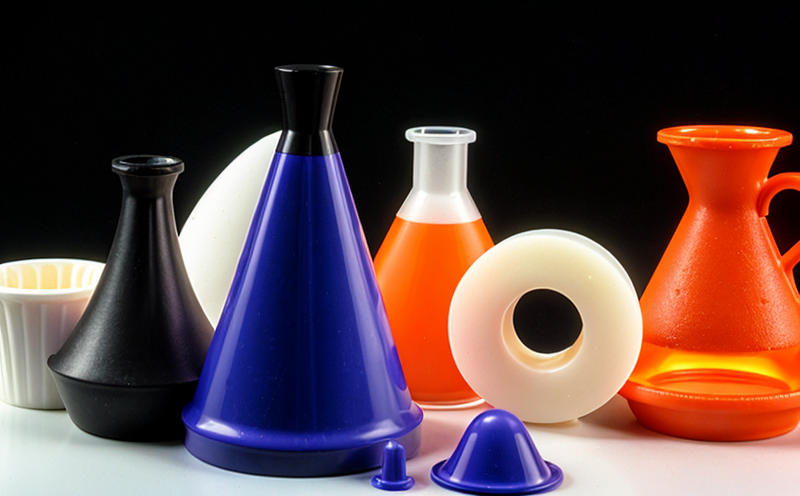Filler Content Testing in Polymers
The filler content testing in polymers is a critical process that ensures product quality and compliance with regulatory standards. Fillers are additives used to modify the properties of polymers, such as improving strength, reducing weight, enhancing electrical conductivity, or altering thermal stability. The accurate determination of filler content is essential for ensuring that these products meet specification requirements and perform as expected in real-world applications.
Our laboratory specializes in providing precise and reliable filler content analysis using advanced analytical techniques tailored to the unique properties of various polymers and fillers. Our team of experts ensures that each sample undergoes thorough preparation, including drying at specified temperatures and conditioning according to relevant standards such as ISO 1183-1 for thermoplastics.
The primary goal of filler content testing is to quantify the amount of filler present in a polymer matrix. This process involves several steps:
- Sample Collection: Proper sample collection methods are critical to avoid bias and ensure accurate results.
- Preparation: Samples must be prepared according to standard procedures, which may include grinding, sieving, or cutting into small pieces depending on the type of filler used.
- Analysis: Advanced analytical instruments like FTIR (Fourier Transform Infrared Spectroscopy), XRD (X-ray Diffraction), and SEM (Scanning Electron Microscope) are employed to identify and measure the amount of filler in the polymer matrix.
- Reporting: Results are reported based on internationally recognized standards, ensuring consistency across industries.
The importance of accurate filler content testing cannot be overstated. It affects many aspects of product performance including mechanical properties, thermal stability, electrical conductivity, and more. For instance, if too much filler is present, it could lead to issues like reduced flexibility or increased brittleness; conversely, insufficient amounts might result in suboptimal performance.
Our laboratory adheres strictly to industry best practices when conducting these tests. We use state-of-the-art equipment and follow stringent quality control measures throughout the entire process. By doing so, we guarantee high accuracy and reproducibility of results.
To sum up, filler content testing plays a pivotal role in ensuring product quality by providing insight into how fillers influence polymer behavior. With our expertise and advanced facilities, you can rest assured that your samples will receive thorough analysis leading to reliable data on filler content.
Applied Standards
The filler content testing in polymers follows several international standards which provide guidelines for sample preparation and analysis methods. These include:
- ISO 1183-1: This standard specifies the procedure for determining the mass of a thermoplastic resin used to produce test specimens by measuring the weight change after drying at specific temperatures.
- ASTM D6549: Also known as 'Standard Practice for Reporting Filler Content in Plastics', this document provides recommendations on how to report filler content percentages based on different analytical techniques.
In addition to these general standards, there are also sector-specific guidelines depending on the type of polymer being tested. For example:
- EN 13902: Pertains specifically to testing fillers in polyolefins such as PE (Polyethylene) and PP (Polypropylene).
- IEC 60784-2: Relevant for determining filler content in electrical insulating materials.
By adhering to these standards, we ensure that our results are not only accurate but also comparable with those from other laboratories worldwide. This consistency is crucial for maintaining trust within the industry and facilitating international trade.
Benefits
Filler content testing offers numerous benefits across various sectors including manufacturing industries where polymers play a key role in product development. Here are some of the advantages:
- Quality Control: Ensures that the final products meet specified quality standards.
- Cost Efficiency: Helps manufacturers optimize their production processes by identifying optimal filler levels without compromising on performance or cost.
- Innovation: Allows for continuous improvement of existing materials through research and development efforts aimed at discovering new applications for fillers.
- Environmental Impact: Enables companies to make environmentally friendly choices when selecting raw materials, thereby reducing waste generation during manufacturing processes.
In summary, filler content testing is vital not only from a technical standpoint but also economically and ecologically. It supports sustainable practices while enhancing product performance simultaneously.
Customer Impact and Satisfaction
Our clients benefit significantly from our comprehensive filler content testing services. They gain valuable insights into their products' composition, which helps them make informed decisions regarding formulation adjustments or raw material sourcing. Additionally, compliance with regulatory requirements becomes easier due to the precise data provided by our laboratory.
A case in point is a client who needed assistance optimizing the use of fillers in their polyethylene (PE) compounds. By leveraging our expertise and advanced analytical techniques, they were able to reduce filler usage while maintaining product quality. This not only lowered production costs but also decreased environmental impact associated with waste disposal.
Another example involves an R&D team working on developing a new composite material for automotive applications. Our detailed analysis helped them understand the interaction between different types of fillers and base polymers, ultimately leading to improved mechanical properties in their final product. Such success stories illustrate how our services contribute directly towards enhancing customer satisfaction through superior service delivery.
We are committed to delivering exceptional results that meet or exceed expectations set by our clients. Our dedication to accuracy, reliability, and innovation ensures that every project receives the attention it deserves.





